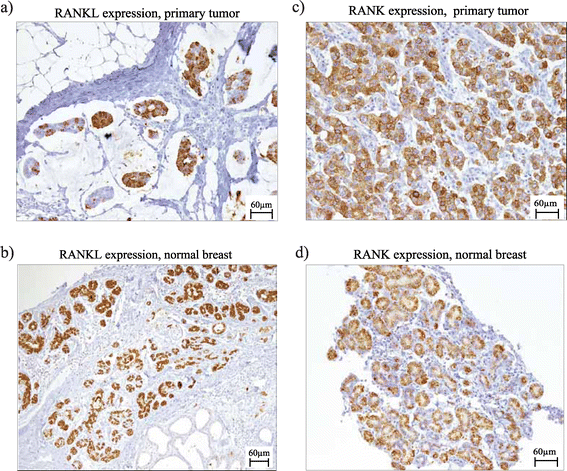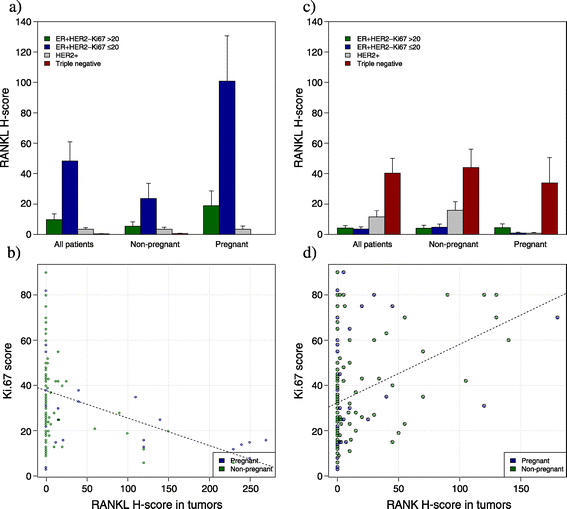RANK-ligand (RANKL) expression in young breast cancer patients and during pregnancy
- PMID: 25849336
- PMCID: PMC4374174
- DOI: 10.1186/s13058-015-0538-7
RANK-ligand (RANKL) expression in young breast cancer patients and during pregnancy
Abstract
Introduction: RANKL is important in mammary gland development during pregnancy and mediates the initiation and progression of progesterone-induced breast cancer. No clinical data are available on the effect of pregnancy on RANK/RANKL expression in young breast cancer patients.
Methods: We used our previously published dataset of 65 pregnant and 130 matched young breast cancer patients with full clinical, pathological, and survival information. 85% of patients had available transcriptomic data as well. RANK/RANKL expression by immunohistochemistry using H-score on the primary tumor and adjacent normal tissue was performed. We examined the difference in expression of RANK/RANKL between pregnant and non-pregnant patients and their association with clinicopathological features and prognosis. We also evaluated genes and pathways associated with RANK/RANKL expression on primary tumors.
Results: RANKL but not RANK expression was more prevalent in the pregnant group, both on the tumor and adjacent normal tissue, independent of other clinicopathological factors (both P <0.001). 18.7% of pregnant and 5.3% of non-pregnant patients had tumors showing ≥10% of cells with 3+ RANKL expression. RANKL expression was significantly higher in progesterone receptor-positive, and luminal A-like tumors, with negative correlation with Ki-67 (all P <0.001). On the contrary, RANK expression was higher in triple negative tumors (P <0.001). Using false discovery rate <0.05, 151 and 1,207 genes were significantly correlated with tumor-expressed RANKL and RANK expression by immunohistochemistry, respectively. High RANKL expression within primary tumor was associated with pathways related to mammary gland development, bone resorption, T-cell proliferation and regulation of chemotaxis, while RANK expression was associated with immune response and proliferation pathways. At a median follow-up of 65 months, neither RANK nor RANKL expression within tumor was associated with disease free survival in pregnant or non-pregnant group.
Conclusions: Pregnancy increases RANKL expression both in normal breast and primary tumors. These results could guide further development of RANKL-targeted therapy.
Figures




References
Publication types
MeSH terms
Substances
LinkOut - more resources
Full Text Sources
Other Literature Sources
Medical
Research Materials

